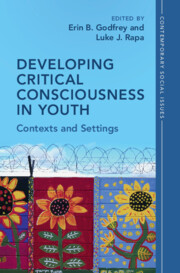Book contents
- Developing Critical Consciousness in Youth
- Contemporary Social Issues Series
- Developing Critical Consciousness in Youth
- Copyright page
- Dedication
- Contents
- Figures
- Tables
- Contributors
- Acknowledgments
- Introduction
- Part I Pedagogical, Curricular, and School-Based Contexts
- Part II Extracurricular Contexts
- 4 Re-envisioning the “Big Three” of Out-of-School Time Programs to Promote Critical Consciousness Development in Youth of Color
- 5 Breaking Down the Arts
- 6 “Listening is Where Love Begins” Advocacy for System-Impacted Youth as a Setting of Critical Consciousness Development
- Part III Societal Contexts
- Index
- References
4 - Re-envisioning the “Big Three” of Out-of-School Time Programs to Promote Critical Consciousness Development in Youth of Color
from Part II - Extracurricular Contexts
Published online by Cambridge University Press: 11 May 2023
- Developing Critical Consciousness in Youth
- Contemporary Social Issues Series
- Developing Critical Consciousness in Youth
- Copyright page
- Dedication
- Contents
- Figures
- Tables
- Contributors
- Acknowledgments
- Introduction
- Part I Pedagogical, Curricular, and School-Based Contexts
- Part II Extracurricular Contexts
- 4 Re-envisioning the “Big Three” of Out-of-School Time Programs to Promote Critical Consciousness Development in Youth of Color
- 5 Breaking Down the Arts
- 6 “Listening is Where Love Begins” Advocacy for System-Impacted Youth as a Setting of Critical Consciousness Development
- Part III Societal Contexts
- Index
- References
Summary
Although conceptual frameworks of critical consciousness development emphasize the importance of social contexts, a comprehensive understanding of how out-of-school time (OST) settings support critical consciousness development in youth of color is lacking. In this chapter, we draw on social justice youth development principles and current literature on OST programs to recast the “Big Three” model of effective OST programs to strengthen the model’s relevancy for both youth of color and critical consciousness. Organizing the evidence using this re-envisioned “Big Three” model, we review practices and principles of after-school programs, mentoring programs, and youth-adult relationships linked to critical consciousness development. Based on this review, we provide implications for practitioners, policy makers, and scholars to foster critical consciousness in youth of color through OST programs.
- Type
- Chapter
- Information
- Developing Critical Consciousness in YouthContexts and Settings, pp. 93 - 121Publisher: Cambridge University PressPrint publication year: 2023



